Motorcycle helmets have been around in one form or another since the motorcycle was first invented. In the old days, these helmets were often not much more than leather caps lined with cotton to keep your hair out of the way, as well as to have something grippy for your goggles to strap onto. During the cafe racer era, riders began to wear helmets that were made of fiberglass backed by foam and padding, because these helped streamline them in their sprints between towns.
Nowadays, there are so many different types, shapes, styles, and levels of helmets that it can be a bit of a complicated mess to find the exact right helmet for you. With many new riders to our hobby emerging from the global pandemic, which has also seen an uptick in motorcycle sales for the first time in many years, it is the perfect time to take a deep dive into what, really, makes up a helmet.
Of course, you can’t talk about a motorcycle helmet without talking about certifications, and opinions on motorcycle helmet certifications can vary greatly! It’s no wonder new and veteran riders alike are sometimes left tapping their chin, going “What do all these letters and numbers mean?!?”
The Battle of the Certifications: Is There a “Best” Certification? What Do They All Mean?
For this section, we are going to be focusing mainly on the certifications that are present in North America and Europe/Oceania, as these are the areas that have the most similar terminologies and ratings. Both continents share FRHP, SNELL, ECE 22.05, ECE 22.06, while North America also adds the DOT certification.
A Little Science First
One of the key aspects of helmet testing and helmet safety is impact mitigation, measured as peak acceleration. This measurement is often done in Gravities, where 1 G is equal to, well, the force of gravity. When you step on a scale in the morning to see if all the wings you ate at the bar last night have made you heavier, the Earth is pulling you down onto the scale at 1 G (and unfortunately, those wings did add a few ounces to your overall weight!).
Gravity itself is constantly pulling you down into the Earth, which is known in the physics world as constant acceleration. Gravity will always pull at the same rate, give or take a percentage point, everywhere on solid ground. Because it’s a constant, it is also something that can be measured against. This is where peak acceleration comes in, as it is the force of deceleration acting on an object—in this case, a human.
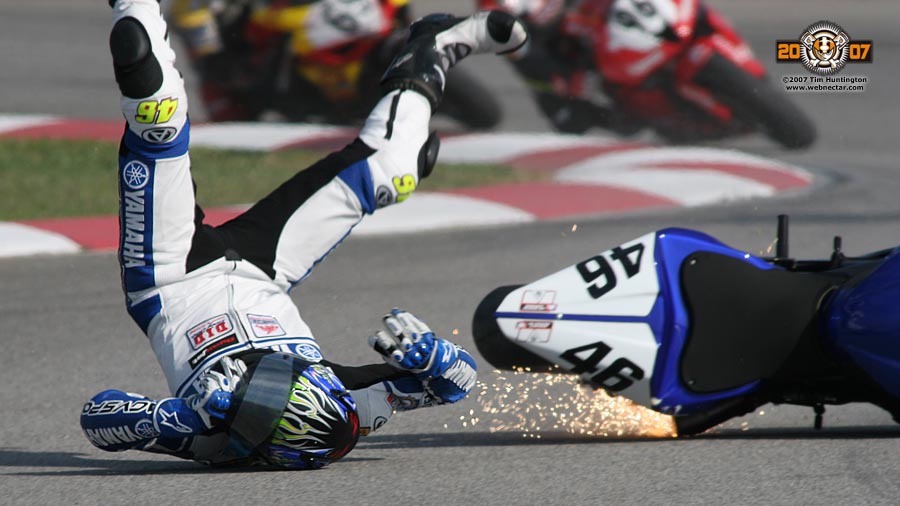
With a helmet, this is measured by a headform weighing 11 or so lbs inside the helmet (which is the average weight of a human head), dropped from a series of standardized heights down a guide bar to strike an anvil.
During the impact, the headform, which is filled with sensors, will register the largest acceleration it encountered. For some certifications, this can be as high as 400 G, which would make that 11 lbs head weight 4,400 lbs, or 2.2 tons, for about a quarter of a second.
With that out of the way, on to the certifications!
DOT
The certifications that most riders are familiar with are DOT and ECE. DOT stands for Department Of Transportation and is the absolute base level certification any helmet must have to be sold in North America.
The DOT certification is also sometimes coded as FMVSS 218, which is article #218 in the Federal Motor Vehicle Safety Standards, and which, at the bare minimum, requires any helmet seeking certification to cover at least the top of the head, or as the V-twin cruiser guys like to call it, the “brain pan.”
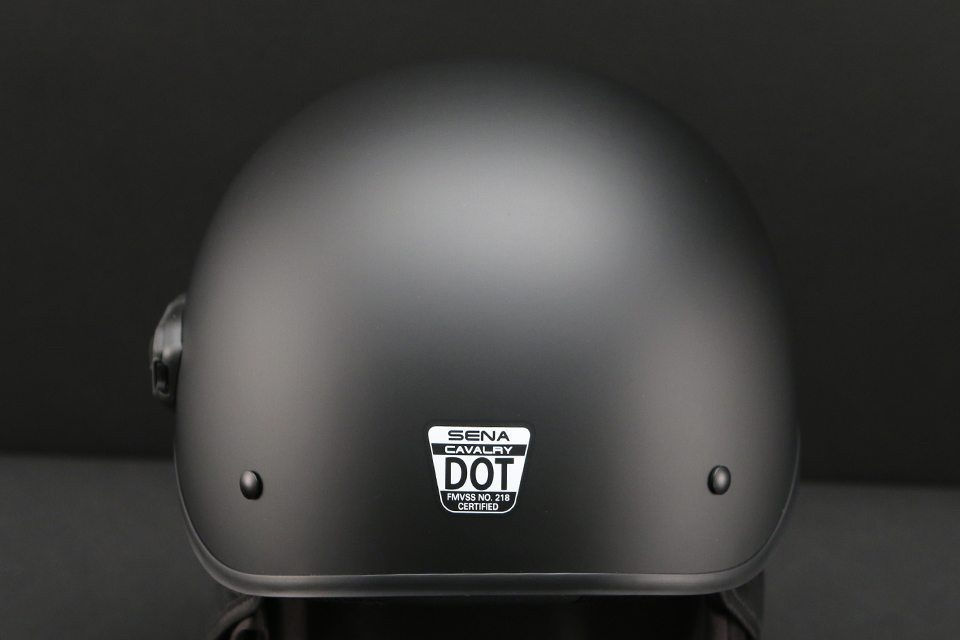
One thing that is specific about the DOT certification is that there is no central lab or testing station that helmets must be sent through. Instead, each manufacturer must provide a signed and official data sheet showing that their helmet meets or exceeds the minimum protection required for certification. Those minimums are:
- Peak acceleration with an 11 lbs weighed headform inside the helmet must not exceed 400 G when impacted on the top of the helmet.
- The helmet must not allow a piercing test striker, dropped from a mandated height, to penetrate the helmet to the point of contacting a headform.
- The retention system (chin strap) must be able to withstand a load of 136 KG (299.2 lbs) for 120 seconds without stretching or displacing from its mounts.
- Peripheral vision in full face, open face, and modular helmets must be 105 degrees or better.
The biggest advantage of the DOT certification is that it allows for testing and certification on a rapid schedule, as every helmet worn while riding a motorcycle in the USA and Canada must carry a DOT certification sticker. If this testing was centralized in a lab, by the time a company’s latest and greatest helmet made it through, they’d have already introduced the next version of it.
The biggest disadvantage of the DOT certification is that some manufacturers in the past have danced a fine line along the requirements for a helmet. This is mostly seen in half helmets, the aforementioned “brain pan” helmets, which offer little-to-no rear, side, or frontal protection—only for the top of the head.
There is also potential for abuse with this certification, which can result in manufacturers that falsify their numbers being slapped with everything from a mild fine (a few hundred thousand dollars) to being taken to Federal court and being sued by the DOT for millions.
ECE 22.05
The Economic Commission for Europe is the certifying body here, and unlike the DOT certification, requires that an accredited, approved, often independent lab test any helmet against their requirements before a certification can be applied. The 22.05 version of the certification, or the 5th amendment of article 22 for personal protective gear, has been around for well over a decade now, and is much more stringent than the DOT requirements.
The biggest difference is in how many areas of the helmet are tested in impacts. In the DOT test, the measurement is only taken across the top of the helmet. With the ECE, peak acceleration is tested on the sides, the rear, the top—and if it’s a full face or modular, the chin bar.
Unlike the DOT’s massive 400 G allowance, any helmet that wants ECE certification must show a peak acceleration at or lower than 275 G. This is still a lot of force, but it is a number that has a higher survival chance than 400 G’s. Also unlike the DOT’s test, the helmet is struck against two anvils, one flat like the DOT one, the other a curved one to simulate a roadside curb.
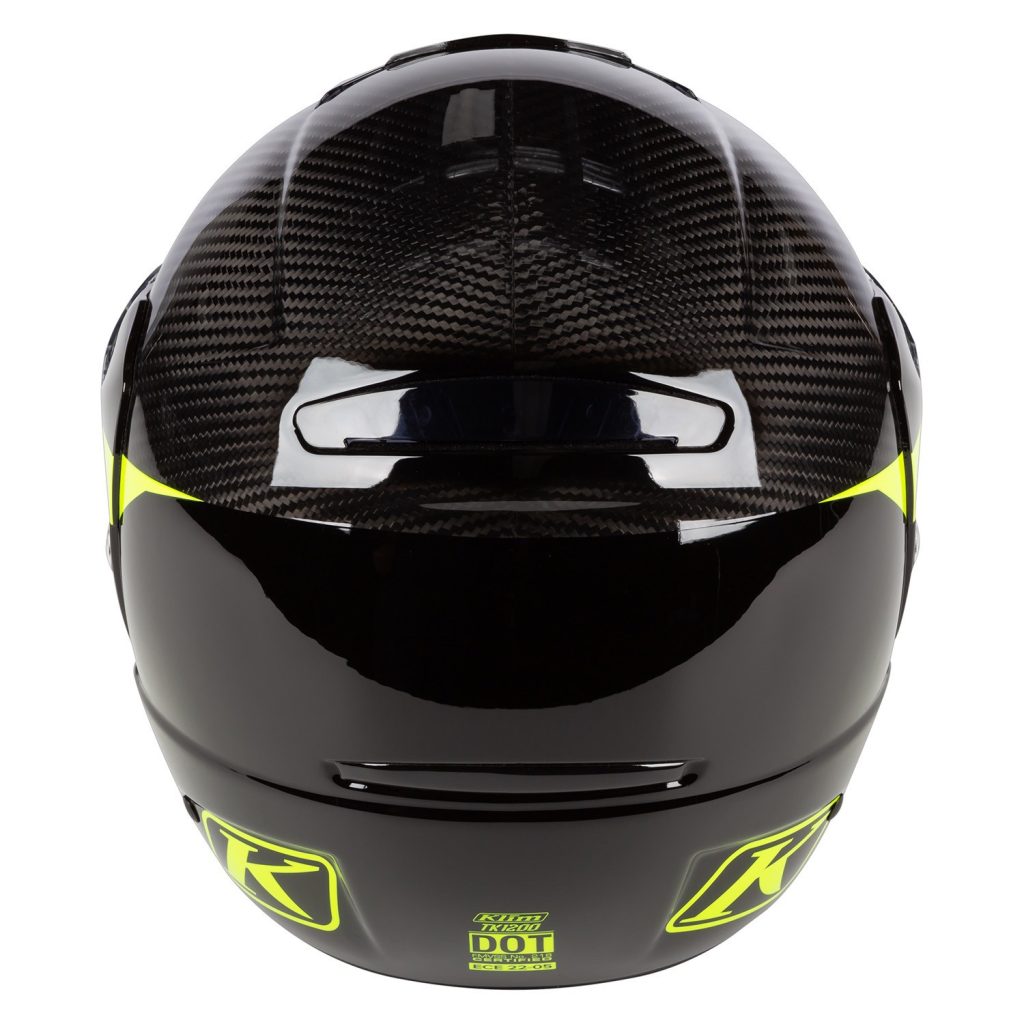
The ECE certification also tests the resilience of the helmet shell against abrasion, as well as measuring the friction required to “grab” the helmet and make it twist, which simulates a rider sliding down the road and having the helmet twist violently, causing neck injuries. The shell and EPS foam are also subjected to a force of up to 630 Newtons of pressure, and the helmet must be able to withstand at least 200 Newtons before starting to deform in any way.
Where the ECE 22.05 certification standard falls a bit short, however, is that, like the DOT test, the impacts are guided impacts, dropping the helmet at all angles down a specific line to hit the anvil the same way each time. If there is one thing about coming off a motorcycle at speed that is not under any control of anyone, it’s how the helmet will come down on the ground.
Helmets made before the end of 2021 that had the ECE 22.05 certification are still perfectly legal to use and ride with, and are often better than helmets with just a DOT sticker. However, the ECE just released amendment 6, meaning…
ECE 22.06
As of January 1, 2022, ECE 22.06 brought about a new certification requirement for helmets to be legally sold in Europe and the UK. The biggest changes are that instead of needing 17 helmets to perform all of the certification tests twice, 33 helmets are now needed from a series to both broaden the sample base and perform many of the impact tests four times.
A new visor penetration test has been added to go along with the shell penetration tests carried out on helmets, where a visor will be shot with a steel ball about the size of a piece of gravel from an air rifle at just over 10 centimeters distance, with a muzzle velocity of 60 m/s. The steel ball must not penetrate, and the visor must maintain its structural integrity, no matter where it is shot. This means that if a visor shows cracking after being shot, that helmet may not pass the certification test!
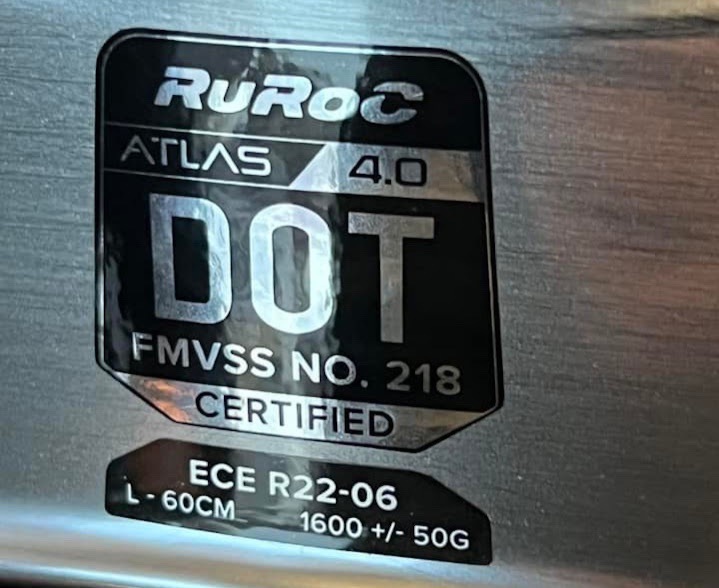
The peak acceleration test has been tightened down to 250 G’s, with plans in the near future to bring it down to 225 G’s as materials and methods of construction improve. Impact tests are also now done with a freefall-style test, where instead of being dropped down a guide pole, the helmet is now dropped down a chute, whereby the impacts are measured both with peak acceleration and peak rotation.
Peak rotation is a new part of the certification, as research has shown that most head injuries in motorcycle accidents happen because the brain not only gets violently shaken but the head often rotates as well—and mitigating that rotation helps prevent injuries.
The final difference over the 22.05 test is that two of the test helmets will be subjected to extreme weather testing. One will undergo impact testing after being thoroughly chilled to -20 °C (-4 °F), and the other after being heated to over 40 °C (104 °F), to find out how well the EPS holds up in these temperatures.
ECE 22.05 testing no longer occurs, so from now until the next amendment, 22.06 is the standard you want to look for on the helmet’s certification sticker.
SNELL
The Snell Foundation is a bit of an interesting place, as two of our staff found out when wBW visited Snell a few years back. A totally voluntary certification, the much-valued SNELL M certification is often considered the top tier of North American certifications. This is because when a helmet goes to Snell Labs, it literally goes to hell.
First of all, their impact testing is important in two ways. One, it does the “send the helmet down a chute” freefall-style test that the ECE 22.06 certification process now uses, and two, it does it from 15 feet, a full 5 feet higher than 22.06!
Another big thing about Snell’s testing is that if a helmet passes their peak acceleration limit of 275 G but comes close to it, that doesn’t necessarily mean that the helmet will get the certification. More often than not, Snell will request another helmet from the manufacturer to do a control test on it, to see if the values repeat or vary.

Snell also puts helmets through the weather chamber, from -20 °C and covered in ice, to 25 °C above room temperature while also spraying water at it constantly for 4 hours to make sure the thing is utterly soaked. Then they drop it on a variety of shaped anvils anyways, because that’s what they do.
They, like everyone else, do penetration tests at random points all over the helmet, perform a visor ballistics test, and then add in one test that only one other certification does, which can generously be called a game of “toss the helmet into the test chamber.”
Because impacts can happen at any random angle and velocity, one of the tests Snell does is give a helmet with an 11 lbs headform in it a mighty heave-ho through a door into a test chamber, trying to hit an anvil with it. The floor and walls are solid concrete, so even if the tester misses, the helmet will still land any one of a million ways on the ground. This is done quite a few times, to get the best sample set of data.
If a helmet passes all of these tests and does so by a significant margin, only then will the SNELL M sticker be applied. Right now, the current certifications are M2020D and M2020R—the difference being that the R-style certification also meets global standards of all certification bodies that submitted their certification limits to Snell.
It is a misconception that the M2020R certification means “Racing,” which it does not—yet many tracks across the US and Canada will not let you attend a track day unless you have a SNELL M2015 or M2020 certification on your helmet!
For those that want to have race helmets for the street, there is one more certification level for you…
FRHP: FIM Racing Homologation Programme
If you want to have a helmet that has gone through the absolute wringer of testing and has had probably over 50 units destructively tested with the strictest of protocols and requirements, then you need to look for the little holographic sticker on the chinstrap or back of a helmet that displays FRHPhe-01 or better.
The reason this certification is one of the rarest in the world is that it is the certification needed to have a helmet approved for world championship-level racing. We’re not talking about a local race at Laguna Seca or Brands Hatch, no. These are helmets that will be worn by those with names like Marquez, Rossi, and Rea. These are helmets that cannot, under any circumstance, fail any one of the fifty or so test items required to be approved for MotoGP and World SBK championships.
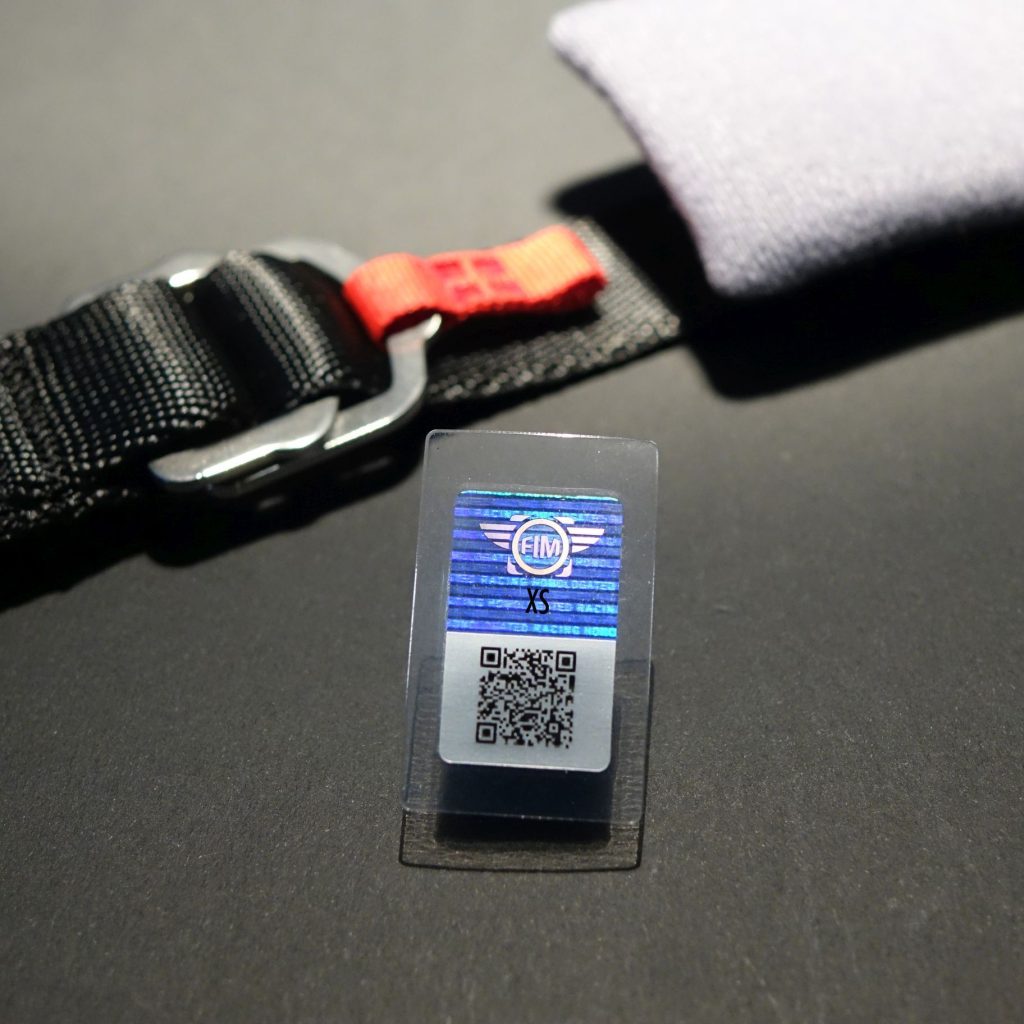
This testing includes random impact and rotational impact testing, multiple levels of visor ballistic testing, and deformation and structural testing that will far exceed human survival limits without even a hint of deformation, delamination, or cracking—and the list goes on. On top of that, the helmets will be tested in various conditions, such as simulated tropical heat, freezing Baltic winds and temperatures, and everything in between.
The goal of these helmet tests are to protect riders that come off a bike not at 60 or 80 MPH, but at 200 MPH or faster. As well, motorcycle racers are the ones most likely to experience an impact falling from 10 to 15 feet in the air if they launched into a highside, so the FIM tests the helmets with a 22 lbs headform (twice the weight of an average head) from 20 feet.
While the full list of testing required is not widely circulated in the public, of the thousand or so helmets that have been sent to the FIM for FRHP certification, only 30 have received the holographic sticker of approval. That is why it is a prized certification and means your helmet is one of the best in the world.
Whoa, Okay, That Was Just the Certifications? What about Shell Materials?
Yes, that was just the certifications.
Equally important in helmet construction and safety are the materials that the outside of the helmet is made of. We want to make it absolutely clear that price should never be a determining factor in finding your helmet. If you look at an AGV Pista GP RR helmet and think it’s overpriced because it’s almost $2,000, keep in mind that it is one of the few with an FRHP sticker and is made out of the best weaves of carbon fiber and kevlar you can get.
Then consider that an HJC i10 for $150, which has a SNELL M2020R rating, protects you just as well with an advanced polycarbonate (read: fancy high-durability plastic) shell over a well-designed, superbly-engineered EPS foam backing.
While there are many types and names of materials that helmets are made from, there are four major categories that encompass 99% of them.
Plastics (Polycarbonates)
Often found in the budget-to-mid-market helmets, the plastics used in helmets have been carefully engineered to provide enough tensile strength, while also being elastic enough, to not shatter should you come off your bike at speed. You will often see fancy names like “advanced polycarbonate,” “synthetic reinforced shell,” “ABS thermoformed shell,” and the like, but they all mean the same thing: plastic.
That said, well-engineered plastic is incredibly durable stuff. Next time you hop in your car to go for a drive, look at the belt buckle you click your seatbelt into. Unless you’re driving something that is well North of “the common car,” you are looking at a bit of well-engineered, extremely robust, durable plastic.
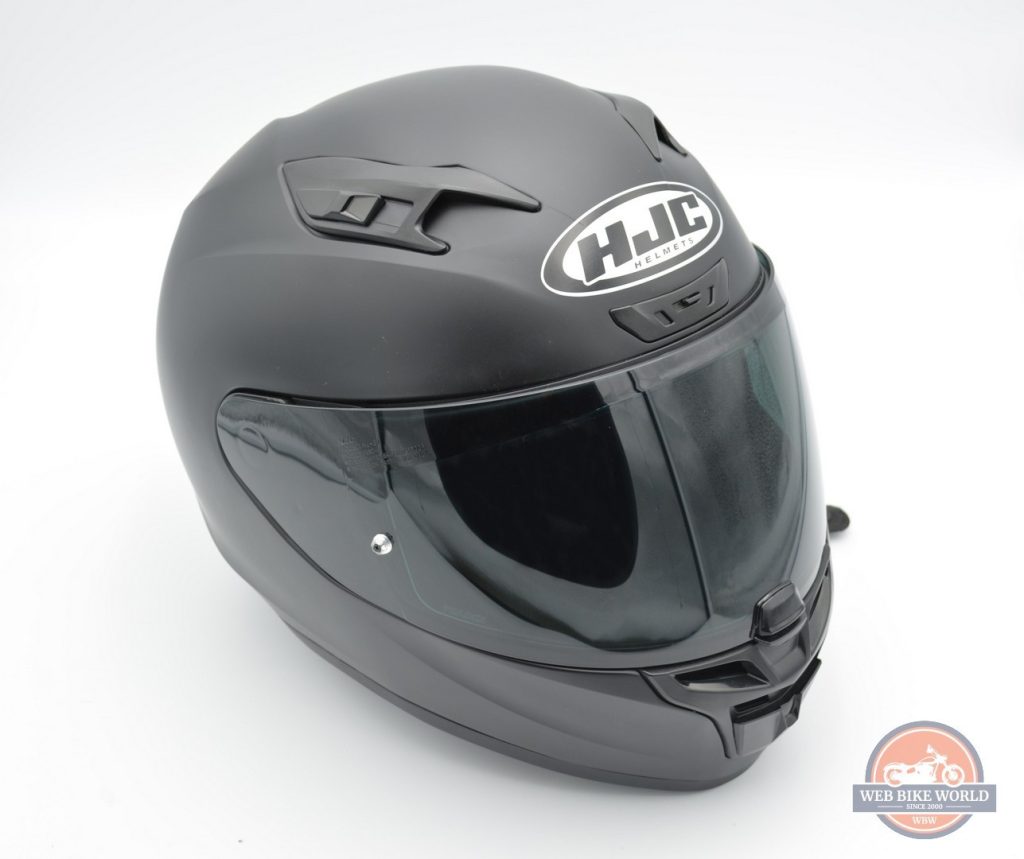
As well, 99.99% of all helmet visors in the world—not just for motorcycle helmets but for such high-end helmets as those used in Formula One or the World Rally Championship—are all polycarbonates. There are some strict and stringent ratings for those visors that make them nigh-on bulletproof, but the fact remains that once again, you’re looking through a sheet of high-quality plastic.
Composites (Organic Fibers, Synthetics, etc.)
Starting at around the $450 mark, you’ll see a marked shift in the descriptions of helmets that change from polycarbonates alone to “polycarbonate composites,” “composite fiber,” or just “composite materials.” Composite materials are made up of multiple different parts to form a combined and/or bound whole.
A lot of the time when talking about composites, there will be mention of a material simply called “organic fibers.” This is a bit of a trick by many manufacturers to not get sued by DuPont chemicals, because what those fibers are is a layer of aramid weave—also known by its DuPont-trademarked name, Kevlar. The same weave that you get in a bulletproof vest is often incorporated into composite helmets.
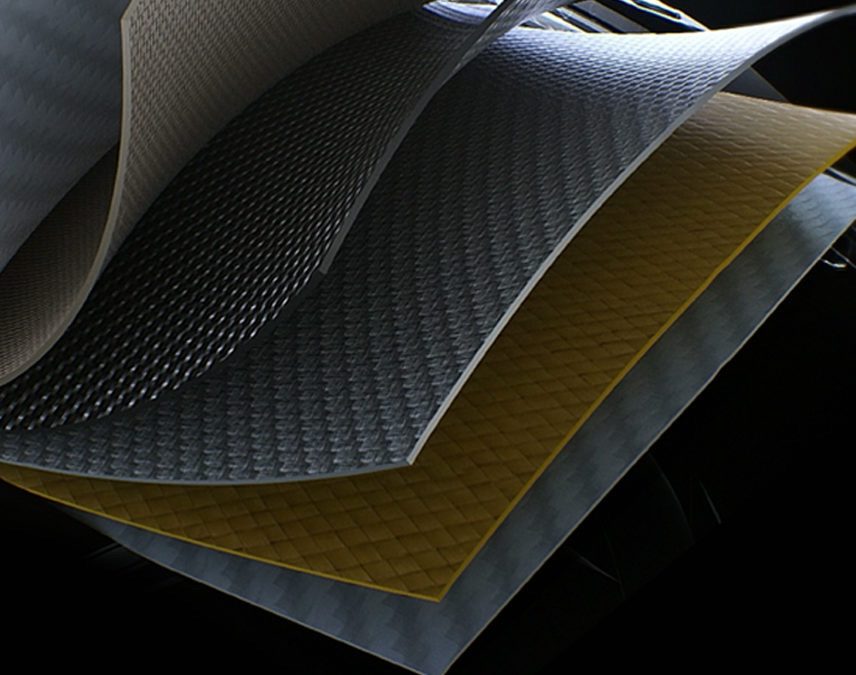
The reason for this is twofold. The first reason is that aramid is a ridiculously resilient material that can absorb and distribute incredible loads across its surface. The second reason is that when woven into a textile, the aramid fibers also make a superb lattice to bind other chemicals to. This is why you will often find composite helmets having descriptions with words like “resin impregnated,” “formed,” or “cast” in reference to their shells.
The benefits of composites are numerous. They are often lighter than plastics while being much stronger and, with the aramid, elastic enough to absorb a lot of impact energy before transferring it to the EPS foam behind the shell. It is also in this area of the helmet’s price and materials range that you will find a lot of ADV-specific helmets, due to the resilient nature of the materials.
Fiberglass (Woven, Single Continuous Strand, Laminate, Random Weave, etc.)
Did you know that the first official motorcycle helmet from Bell Helmets was made out of fiberglass? This material, in one shape or another, has been around for about a century, but it wasn’t until the mid-20th century, when resins were found that bonded extremely well with fiberglass, that it started to become a material that could be used for safety.
Nowadays, there are multiple types and ways of shaping fiberglass into a helmet shell. Some will simply press patches of fiberglass into a mold before pressure forming it with resin so that the materials bond. Others may use what is known as single continuous strand, where a machine weaves a single, miles-long strand of fiberglass over itself again and again until a shell is formed, at which point it also gets the resin treatment.
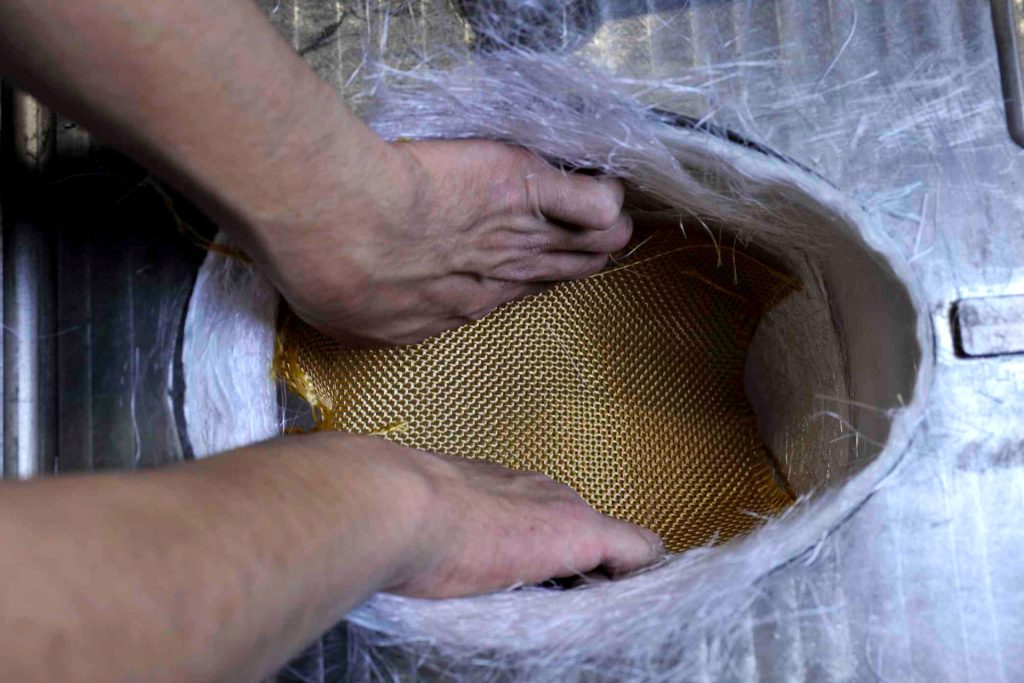
Fiberglass helmets come in a wide range of qualities and price ranges. You can get a mixed fiberglass-composite helmet for about $500, or go for a resin-impregnated fiberglass helmet like the ones from Arai for up to $1,000.
The reason such helmets are so expensive is because of how Arai helmet shells are made, using a laminate fiberglass process that gives the shell incredible strength while being extremely lightweight. They are then hand-assembled and, during the manufacturing process, if any worker along the way notices that a helmet has even the smallest defect, they can pull it from the assembly line as a reject.
Fiberglass does have one major flaw, however, in that if it is subjected to an extreme enough temperature change—for example if you left your helmet in the detached garage the other day and it froze overnight—it can form microfractures. The temperature change really has to be drastic for this to occur, so the following tip really only applies to those living in the Northern states and Canada: always bring your helmet inside with you after a ride!
Carbon Fiber (Carbon-Kevlar, Carbon Composite, etc.)
As this article is written, carbon fiber is the current top-tier material a helmet can be made of. This is mostly because of how naturally strong carbon fiber is, while also being one of the strongest man-made materials in terms of tensile strength to thickness.
This is because of the unique way carbon atoms align and bond when in a vacuum and under intense heat, forming a crystalline lattice that is then often coated with a polycarbonate resin to hold those bonds together.
What results is a material that is as strong as steel but weighs barely a fraction of an equally-sized bit of metal. If you were to take a 1 x 1 foot square of steel in one hand, and then the same size square made from carbon fiber in the other, the hand holding the carbon wouldn’t feel like it had any weight at all in it.
As well, since carbon fiber has been around for a while now (nearly 40 years) multiple combination materials have been made that make the material even more resilient. Carbon-Kevlar is one such material, as carbon loves to bond with the microscopic lattice of Kevlar to become a combined material with excellent strength and elasticity.
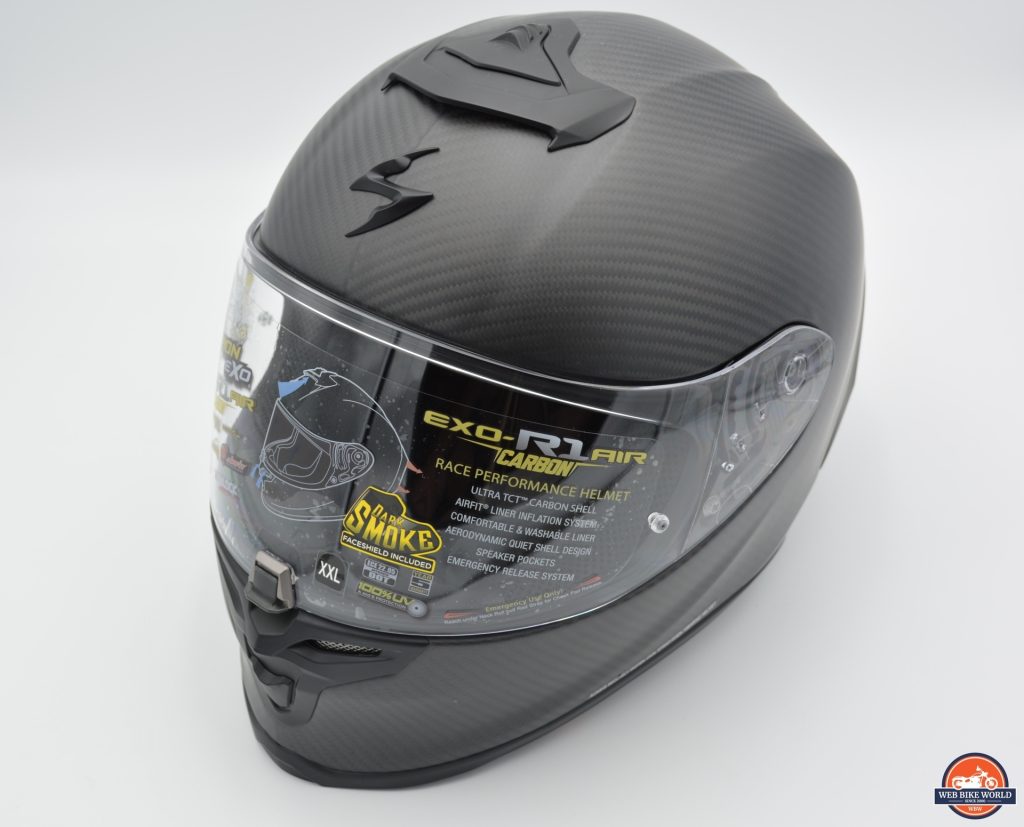
Another consideration with carbon fiber is what is known as the weave density. For example, the AGV Pista GP RR helmet we mentioned early has a weave density of around 5,000, which is the same type of density that Formula One race cars and MotoGP race bikes use for their frames and panels. The Scorpion R1 Air Carbon, on the other hand, boasts a still-excellent weave density of 3,000 and is made of the exact same type of carbon fiber that jetliner aircraft wings are made of.
How Materials Are Developed for Helmets
As has been shown above, there are many, many, many materials that helmets can be made of, although they still fall into four basic groups. The key factor among all of them, however, is that they all have some balance between structural stability and elasticity. “But,” we can already hear you asking, “why would a helmet need to be elastic?”
It may be a little grim, but sometimes innovations come about via tragedy. When the first fiberglass helmets started to appear from Bell, AGV, and others, they were often lined with just padding so that the helmet fit comfortably, with little to no consideration about what was between the shell and the head otherwise.
Furthermore, the fiberglass in these helmets was hard cured, meaning that the helmet was a rigid structure with little to no flex. Cars of the time were built the same way, with rigid frames and heavy-duty exteriors to “protect” the driver and passengers—and yet when two cars collided on the road, injuries and death still occurred.
No one can really pin down the exact moment that someone had a “Eureka!” moment, but it is often attributed to Bell, as a racing helmet pioneer, discovering that it didn’t give much help to a rider or driver to just have a rigid structure around their head with a lot of padding if that padding didn’t affect the force being transferred to the head. That is where the first thoughts came from about making helmets strong but flexible structures—as well as adding a buffer layer between the shell and the padding made of strong but collapsible material.
EPS (Expanded PolyStyrene), common even in helmets today, started to line the shells of helmets, although the type used in the 1950s and 1960s was a far cry from the advanced multi-layer, multi-density type we have today. The fiberglass shells started to be multiple layers themselves, with a tough outer shell laid over a less rigid inner shell that deformed and flexed.
All of sudden, in major accidents, helmets were getting destroyed, but riders started to be able to walk away. What was happening is that the outer shell would take the impact force and absorb some of it through tensile strength before cracking, while that inner shell was able to deform and stretch and compress enough to distribute the impact energy over a wide area before the EPS foam started to collapse and disperse massive amounts of kinetic energy.
An easy way to think of this is by pushing a single finger into the palm of your other hand. You can feel that you need to have your finger rigid, straight, and supported to be able to push on your palm with any significance. Then, if you push with two fingers, suddenly you don’t need either to be as rigid to apply the same force, because that force is now a) over a wider area and b) being applied by double the surface area.
That, in short, is why materials for helmets have been developed over the past 45 or so years to be strong yet elastic. The shell of the helmet serves to take what might be a large load of kinetic energy on a single point on your head, and distribute it over a wide area in an effect known as kinetic dispersion before the EPS foam liner starts to collapse and absorb that energy. If you want to think of it in automotive terms, the shell and foam of a helmet are the crumple zones to keep the main cabin, i.e. your head, safe.
Yet, as much as advancements have been made in EPS liners, shell materials, and the like over the past decades, helmets are starting to see another major shift in thought and design…
New & Exciting Concepts, Prototypes, & Some Helmets on the Market Right Now
Motorcycle helmets have, with a few advances, remained pretty much the same since the mid-2000s. The shape has been perfected, EPS liners have only so much innovation that can be done with them, and it’s been more of a process of refinement than innovation. However, we, as humans, always like to find new and exciting ways to do things, and the helmet industry is at a major crossroads now.
While shells are pretty much the best they will be until some new and better material is discovered, a lot of innovation is starting to come out regarding the inside of the helmet, specifically the layer used to disperse energy. EPS is still the de facto standard, but that may not be the case for long.
Recently, a technology known as the Multi-directional Impact Protection System, or MIPS, has been included in quite a few Bell helmets, as well as starting to appear across multiple brands in the 2022 helmet market. This technology uses a small cradle of material attached to the inside of the EPS layer so that it rests against your head.
The material is mounted in such a way that it will flex before it starts to actually move, delaying the transfer of rotational energy to the head and gradually accelerating the head instead of allowing it to “snap” with the rotation of a helmet.
While this delay in acceleration may only be for a tenth of a second, it is “slow” enough that it has been shown to prevent traumatic brain injury, concussions, and other nasty rotational injuries in the same way that the shell of a helmet distributes impact energy. That delay, short as it may be, allows the brain to start to turn with the skull, instead of being bashed against it.
It may seem insignificant, but it is so revolutionary that multiple powersports and motorsports organizations are looking at including requirements for something like MIPS to protect their riders and drivers during crashes.
Another major innovation in helmet technology is a material known as Koroyd. While MIPS works with the EPS layer to help protect the wearer, Koroyd seeks to replace the EPS layer entirely.
After an airplane crash in 1989, namely flight BD092 at Kegworth, England, the cause of death of 9 of the 47 fatalities was found not to be through severe blunt force trauma, but through internal head and torso injuries after the kinetic energy of the crash was transferred through their seats. Investigations showed that the at-the-time-normal mountings of seats on hard, square frame subflooring contributed to that transfer of energy.
It was from the findings of those investigations—namely, that a cylindrical tube structure had far greater kinetic energy absorption potential—that Koroyd was born. Using a welded-tube lattice, Koroyd replaces the foam entirely on the inside of a helmet, which results in a lighter helmet overall without sacrificing any safety.
Another major benefit of Koroyd is that, because it is made up of hollow tubes, heat transfer is far greater than with EPS foam, allowing the vents on the helmet to work far more efficiently to keep a rider cool.
Koroyd has two major partners in the motorcycle field, namely Thor Racing and Klim, as well as providing their own brand of body armor inserts for standard back, shoulder, and elbow protector armor pockets in everyday motorcycle gear. You can find Koroyd linings in the Klim Krios Pro Carbon, the Klim F5, and the Thor Racing Reflex MX helmets.
Another major innovation that has just started to appear on the market, which has been designed to work alongside both MIPS and Koroyd, or on its own entirely, is a technology with the tongue-twister name of Elastomeric Isolation Damping (EID). In simplest terms, helmet manufacturer 6D took an idea from heavy-duty industries—namely, rubberized damper mounts for items that may cause a lot of vibration—and miniaturized it, then put it between the shell and the EPS liner in a helmet.
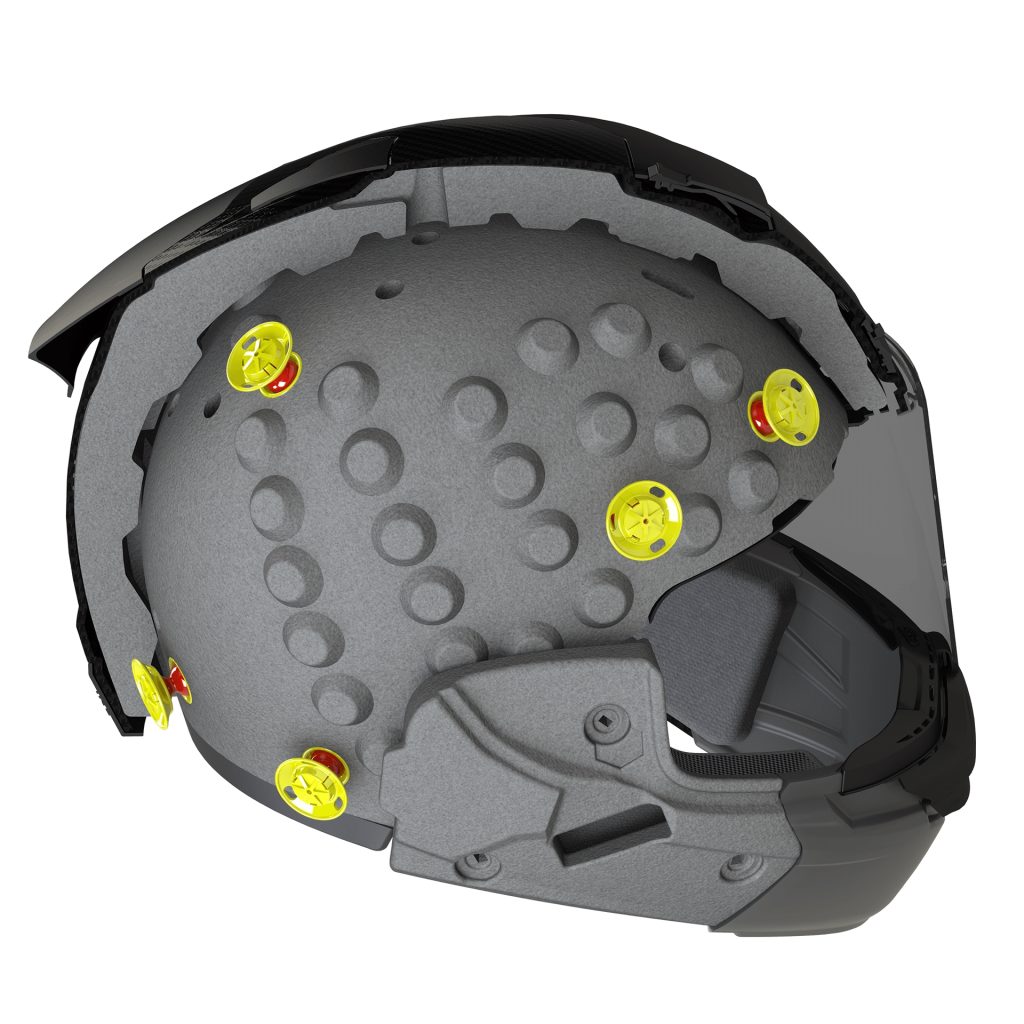
Much like how MIPS works, these dampers are there to absorb the first few moments of rotation in an impact. The advantage they have over MIPS, however, is that they are also intentionally compressible, much like how the suspension of the front fork of your motorcycle works. It absorbs impact energy, releases it safely, and then springs back to normal.
While only included in a few of 6D’s helmets, such as their top tier ATR-1 MX helmet, this technology is very promising—and more and more manufacturers are looking at creating their own versions of it.



